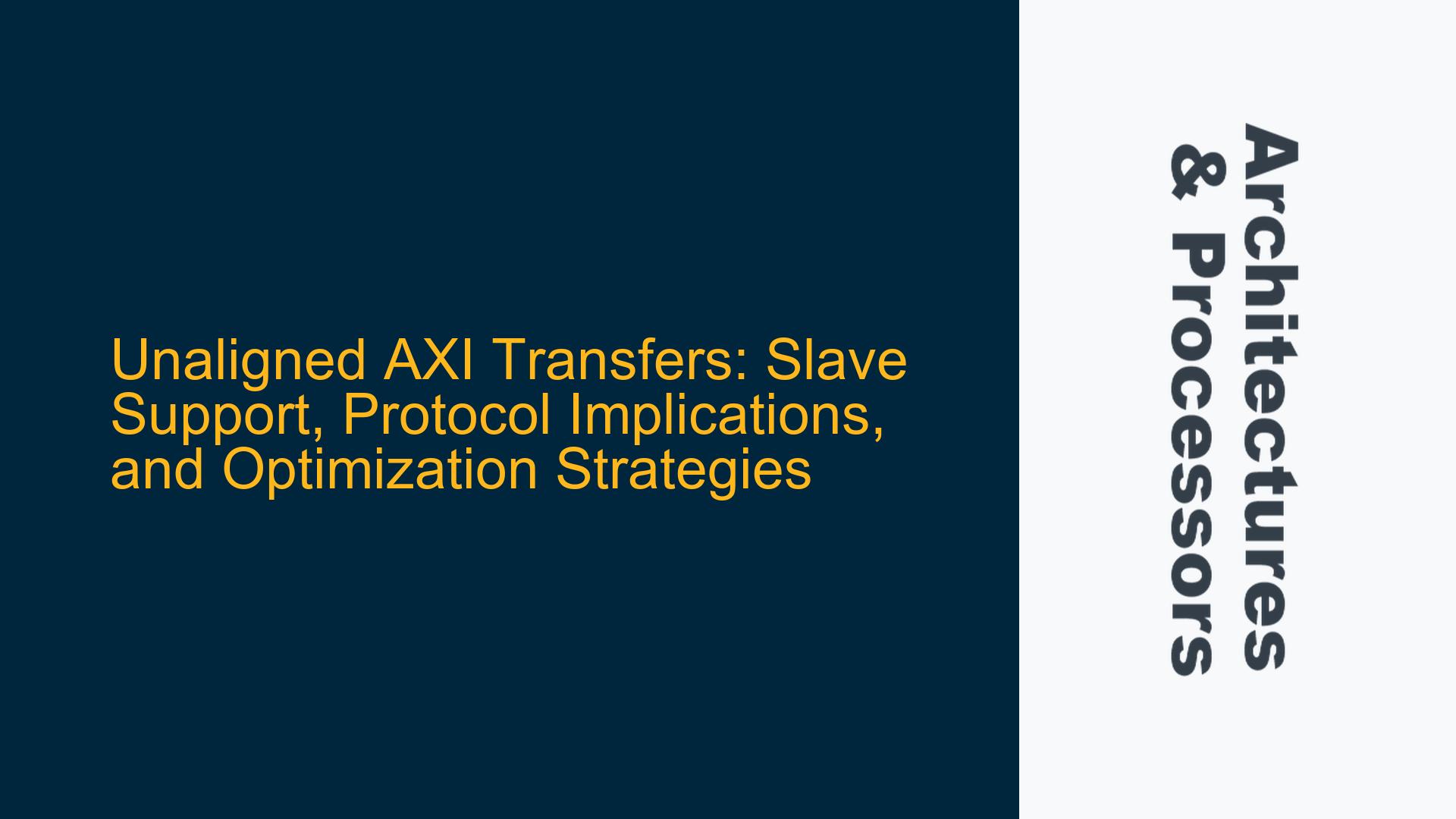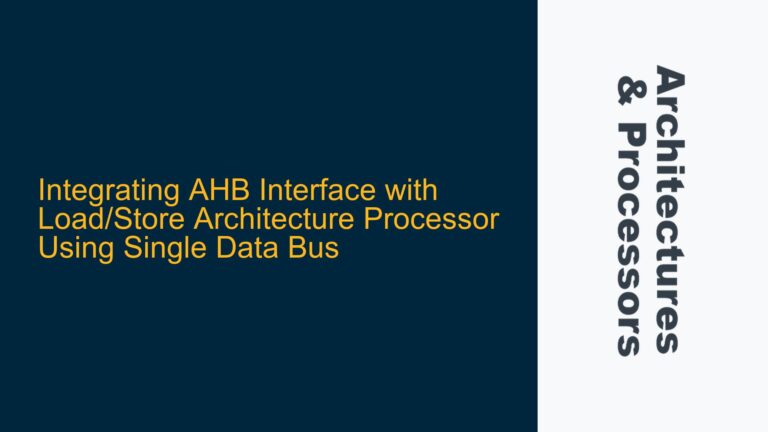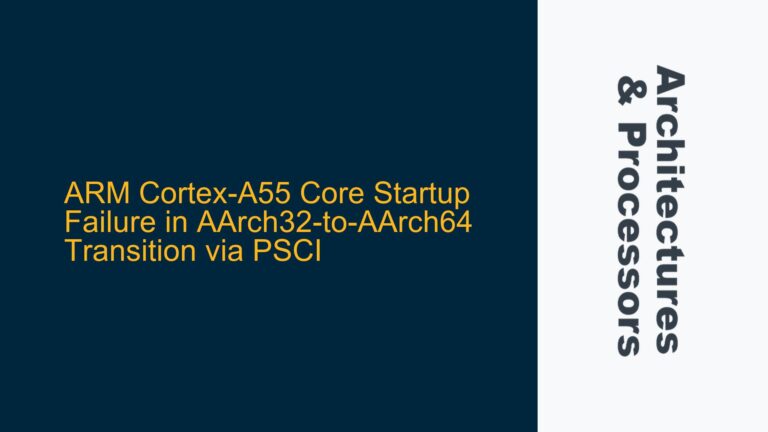Understanding Unaligned AXI Transfers and Slave Support Requirements
Unaligned transfers in the AXI (Advanced eXtensible Interface) protocol refer to data transactions where the starting address of a burst transfer is not aligned to the natural boundary of the data size being transferred. For example, a 32-bit (4-byte) transfer starting at address 0x01 is unaligned because 0x01 is not a multiple of 4. The AXI protocol explicitly allows such unaligned transfers, except for WRAP bursts, which must always be aligned. However, the ability of a slave to handle unaligned transfers depends on its design and functionality.
The AXI protocol does not mandate that slaves take special action based on alignment information from the master. This means that the slave must be capable of handling unaligned transfers, but it does not need to interpret the alignment as having any special meaning beyond the address and data size. For instance, a slave could choose to return a SLVERR (slave error) response if unaligned transfers are incompatible with its operation, but it must still accept the transaction and provide a response.
From a hardware perspective, the master has two primary options for handling unaligned transfers. The first option is to issue a single unaligned burst transaction, which simplifies the master’s bus interface logic but may increase the complexity of the slave’s implementation. The second option is for the master to split the unaligned transfer into multiple aligned transactions, which simplifies the slave’s design but increases bus traffic and master complexity. For example, a 32-bit unaligned transfer starting at address 0x01 could be split into a 3-beat 8-bit burst (covering addresses 0x01-0x03) followed by a 3-beat 32-bit burst (covering addresses 0x04-0x0F) and a final 1-beat 8-bit burst (covering address 0x10).
The choice between these options depends on the specific design goals and constraints of the system. For instance, if minimizing bus traffic is a priority, the master may prefer to issue a single unaligned burst. On the other hand, if simplifying the slave’s design is more important, the master may opt to split the transfer into aligned transactions.
Implications of Unaligned Transfers on System Performance and Design Complexity
Unaligned transfers can have significant implications for system performance and design complexity. From a performance perspective, unaligned transfers typically require more bus cycles to complete compared to aligned transfers. For example, a 32-bit unaligned burst starting at address 0x01 may require five bus transfers to complete, whereas an aligned burst starting at address 0x00 would only require four transfers. This increased cycle count can lead to higher latency and reduced throughput, particularly in systems with high bus utilization.
From a design complexity perspective, unaligned transfers can complicate both the master and slave implementations. For the master, supporting unaligned transfers may require additional logic to handle address calculations, data alignment, and transaction splitting. For the slave, supporting unaligned transfers may require additional logic to handle byte lane masking, data alignment, and error handling. In some cases, the slave may need to implement special handling for unaligned transfers, such as returning a SLVERR response if the transfer is incompatible with its operation.
The impact of unaligned transfers on system performance and design complexity can be mitigated through careful design and optimization. For example, the use of L1 caches can help reduce the occurrence of unaligned transfers by aligning data accesses at the cache line level. Additionally, software can be optimized to minimize the use of unaligned transfers by aligning data structures and access patterns to natural boundaries.
Optimizing AXI Systems for Unaligned Transfers: Best Practices and Solutions
To optimize AXI systems for unaligned transfers, several best practices and solutions can be employed. These include:
-
Leveraging L1 Caches for Alignment: L1 caches can significantly reduce the occurrence of unaligned transfers by aligning data accesses at the cache line level. For example, a 32-bit unaligned read transaction can be fetched as a 32-byte aligned cache line, with the master extracting the requested data from the appropriate byte lanes. This approach simplifies the design of the memory system and improves performance by reducing the number of bus transactions.
-
Using Write Strobes for Unaligned Writes: For unaligned write transactions, the AXI protocol provides write strobes (WSTRB) to indicate which byte lanes contain valid data. The slave can use these strobes to handle unaligned writes without requiring additional logic for address alignment. For example, a 32-bit unaligned write starting at address 0x01 can be handled by setting the WSTRB signal to 0xE (indicating that bytes 1, 2, and 3 are valid) and ignoring the unused byte lane.
-
Splitting Unaligned Transfers into Aligned Transactions: In some cases, it may be beneficial to split unaligned transfers into multiple aligned transactions at the master level. This approach simplifies the slave’s design and can improve bus utilization by reducing the number of unaligned transactions. For example, a 32-bit unaligned read transaction starting at address 0x01 can be split into a 3-beat 8-bit burst (covering addresses 0x01-0x03) and a 3-beat 32-bit burst (covering addresses 0x04-0x0F).
-
Optimizing Software for Alignment: Software can be optimized to minimize the use of unaligned transfers by aligning data structures and access patterns to natural boundaries. This approach reduces the need for hardware support for unaligned transfers and improves system performance. For example, key data structures can be aligned to 32-bit or 64-bit boundaries to ensure that all accesses are naturally aligned.
-
Handling Unaligned Accesses to Device Memory: Unaligned accesses to device memory are generally not supported and should be avoided. Device registers often need to be updated in a single transfer to ensure that all bits are updated simultaneously. Software should ensure that all accesses to device memory are aligned to the natural boundary of the data size being transferred.
By following these best practices and solutions, AXI systems can be optimized to handle unaligned transfers efficiently and effectively. This approach minimizes the impact of unaligned transfers on system performance and design complexity, ensuring reliable and high-performance operation.
| Optimization Strategy | Description | Impact |
|---|---|---|
| Leveraging L1 Caches for Alignment | Aligns data accesses at the cache line level, reducing unaligned transfers. | Simplifies memory system design, improves performance. |
| Using Write Strobes for Unaligned Writes | Utilizes WSTRB signals to handle unaligned writes without additional logic. | Simplifies slave design, ensures correct data handling. |
| Splitting Unaligned Transfers into Aligned Transactions | Breaks unaligned transfers into multiple aligned transactions at the master level. | Reduces bus traffic, simplifies slave design. |
| Optimizing Software for Alignment | Aligns data structures and access patterns to natural boundaries. | Reduces need for hardware support, improves system performance. |
| Handling Unaligned Accesses to Device Memory | Ensures all accesses to device memory are aligned to natural boundaries. | Prevents errors, ensures reliable operation of device registers. |
In conclusion, unaligned transfers in AXI systems present both challenges and opportunities for optimization. By understanding the implications of unaligned transfers on system performance and design complexity, and by employing best practices and solutions, designers can ensure that their AXI systems operate efficiently and reliably. Whether through the use of L1 caches, write strobes, transaction splitting, software optimization, or careful handling of device memory, the key to success lies in a thorough understanding of the AXI protocol and the specific requirements of the system being designed.






